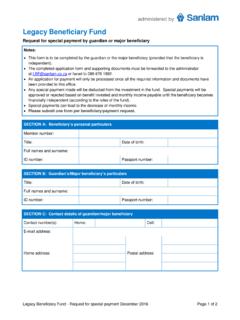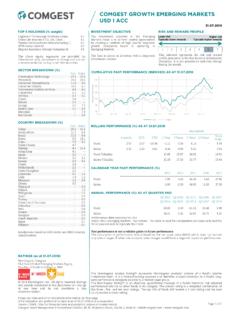Transcription of HEALTH POLICY AND SYSTEMS RESEARCH IN CHINA
1 HEALTH POLICY AND SYSTEMS RESEARCH IN CHINAUNICEF/UNDP/World Bank/WHOS pecial Programme for RESEARCH andTraining in Tropical Diseases (TDR) ShiH. YangM. Gonzalez-BlockE. BlasWorld HEALTH Organization, ChinaAlliance-HPSRC hina HealthEconomicsInstituteIn partnership:TDR/GEN/ World HEALTH Organization on behalf of the Special Programme for RESEARCH and Training in Tropical Diseases, 2004 All rights use of content from this HEALTH information product for all non-commercial education, training and information purposes is encouraged,including translation, quotation and reproduction, in any medium, but the content must not be changed and full acknowledgement of the sourcemust be clearly stated. A copy of any resulting product with such content should be sent to TDR, World HEALTH Organization, Avenue Appia,1211 Geneva 27, Switzerland.
2 TDR is a World HEALTH Organization (WHO) executed UNICEF/UNDP/World Bank/WHO Special Programme for Researchand Training in Tropical information product is not for sale. The use of any information or content whatsoever from it for publicity or advertising, or for any commer-cial or income-generating purpose, is strictly prohibited. No elements of this information product, in part or in whole, may be used to promote anyspecific individual, entity or product, in any manner designations employed and the presentation of material in this HEALTH information product, including maps and other illustrative materials,do not imply the expression of any opinion whatsoever on the part of WHO, including TDR, the authors or any parties cooperating in the produc-tion, concerning the legal status of any country, territory, city or area, or of its authorities, or concerning the delineation of frontiers and or depiction of any specific product or commercial enterprise does not imply endorsement or recommendation by WHO, including TDR,the authors or any parties cooperating in the production.
3 In preference to others of a similar nature not mentioned or views expressed in this HEALTH information product are those of the authors and do not necessarily reflect those of WHO, including , including TDR, and the authors of this HEALTH information product make no warranties or representations regarding the content,presenta-tion, appearance, completeness or accuracy in any medium and shall not be held liable for any damages whatsoever as a result of its use or appli-cation. WHO, including TDR, reserves the right to make updates and changes without notice and accepts no liability for any errors or omissions inthis regard. Any alteration to the original content brought about by display or access through different media is not the responsibility of WHO,including TDR, or the , including TDR, and the authors accept no responsibility whatsoever for any inaccurate advice or information that is provided by sourcesreached via linkages or references to this HEALTH information and layout: Lisa SchwarbPhotos: Erik Blas and Johannes SommerfeldHEALTH POLICY AND SYSTEMS RESEARCH IN ShiH.
4 YangM. Gonzalez-BlockE. BlasWorld HEALTH Organization, ChinaAlliance-HPSRC hina HealthEconomicsInstituteIn partnership:UNICEF/UNDP/World Bank/WHOS pecial Programme for RESEARCH andTraining in Tropical Diseases (TDR) HEALTH POLICY AND SYSTEMS RESEARCH IN CHINA - TDR/GEN/ and abbreviations ..ivForeword ..vExecutive summary ..vi1 Background ..12 POLICY context and challenges .. The five balances .. HEALTH POLICY RESEARCH dialogue ..43 RESEARCH evidence for the 11thFive-year Plan .. Globalization and macroeconomic trends .. Population and HEALTH status trends .. Economic reform and HEALTH care financing ..7 Sources of funding ..7 Allocative efficiency ..7 Insurance ..8 Equity .. Organization and delivery of public HEALTH programmes .. Ownership and governance .. Cost containment and regulation .. Provider performance management.
5 National policies local implementation strategies ..134 RESEARCH needs and SYSTEMS .. RESEARCH needs to close gaps in knowledge .. future RESEARCH needs to close gaps in knowledge .. in RESEARCH capacity .. for closing the gaps ..18 Improving the RESEARCH POLICY dialogue ..18 Contracting-out and commissioning of existing institutions ..18 Creation of new institutions ..19 Capacity building for POLICY and SYSTEMS researchers and POLICY -makers ..195 Conclusion, strategy and way forward ..20 Annex: Directory of HEALTH POLICY RESEARCH institutions ..21 References ..22 About the authors ..24 ContentsHEALTH POLICY AND SYSTEMS RESEARCH IN CHINA - TDR/GEN/ and abbreviations AIDSA cquired immunodeficiency syndrome Alliance-HPSRA lliance for HEALTH POLICY and SYSTEMS ResearchCDCC enter for Disease Control, a public HEALTH institution with responsibility for disease prevention and control in ChinaCMSC ooperative Medical system , a community financing scheme for HEALTH services in rural areas of ChinaCOPDC hronic obstructive pulmonary diseaseCTComputerized tomographyDFIDD epartment for International Development, UKDOTSD irectly Observed Treatment Strategy for TuberculosisEPIE xpanded Programme of ImmunizationEUEuropean UnionGDPG ross domestic productGini coefficientA measure of income inequality, is a number between 0 and 1, where 0 means perfect equality (everyone has the same income)
6 And 1 means perfect inequality (one person has all the income,everyone else has nothing).HIVH uman immunodeficiency virus IDRCI nternational Development RESEARCH Centre, Ottawa, CanadaINCOI nternational Cooperation (EU)MRIM agnetic resonance imaging NGOsNongovernmental organizationsPETP ositron emission tomographyR&DResearch and developmentSARSS evere acute respiratory syndromeTBTuberculosisTDRUNICEF, UNDP, World Bank, WHO Special Programme for Training and RESEARCH in Tropical Diseases UKUnited KingdomUNICEFThe United Nations Children s FundUNDPU nited Nations Development ProgrammeUSAU nited States of AmericaWHOW orld HEALTH OrganizationWTOW orld Trade OrganizationvIn 2003, the Chinese government proposed its strategy for achieving a Xiao Kang society, which is people centered and based on a comprehensive, coordinated, and sustainable development development plan based on five balances between urban and rural areas, regions, social and eco-nomic sectors, humans and nature, and domestic and global markets.
7 Is the main strategy of the newdevelopment concept. HEALTH is an essential element of a Xiao Kang society if the HEALTH of all peo-ple is not improved, it will not be a Xiao Kang society. Thus more attention must be paid to HEALTH dueto its importance in social and economic the past half century, CHINA has, with very limited resources, made progress in improving thehealth status of its people, and this has been recognized throughout the world. CHINA now provideswidely accessible services to most of its billion head of population. However, compared to the aimsof a Xiao Kang society, still more needs to be done to improve the HEALTH sector reform and improvement of the HEALTH system requires RESEARCH to provide scientific evi-dence of the need to re-examine existing HEALTH policies and create more effective policies for thefuture.
8 Over the past two decades, great progress has been made in HEALTH POLICY and systemsresearch, and this has impacted positively on HEALTH reform and document, prepared by the CHINA Network for HEALTH Economics, WHO, TDR, and the Alliance-HPSR, is a product of the HEALTH POLICY Forum held in May 2004 in Beijing, with the participation ofhigh-level POLICY -makers from central and provincial levels as well as researchers. The documentdescribes the social and economic context of the country, carefully considers the opportunities andchallenges facing the government in public HEALTH , and systematically summarizes key RESEARCH find-ings relevant to POLICY -making. More importantly, it identifies knowledge gaps and proposes a numberof options for filling these believe that this document will be helpful for Chinese as well as international readers wishing tounderstand Chinese HEALTH POLICY -making and SYSTEMS RESEARCH , and for identifying areas of coopera-tion.
9 I hope the document will be given the attention it CaiProfessor and Executive DirectorChina Network for HEALTH EconomicsOctober 15, 2004Fo reword HEALTH POLICY AND SYSTEMS RESEARCH IN CHINA - TDR/GEN/ summaryIn the past three decades, along with rapid economicdevelopment in CHINA , the overall living standards of thepopulation have generally improved. However, disparitiesin social and economic development between urban andrural areas, between the eastern and western regions,and between the rich and the poor have increased. Thehealth status of the population has improved, but therate of improvement has reached a plateau. While non-communicable diseases have become the major diseaseburden, infectious diseases such as tuberculosis, hepati-tis, and schistosomiasis are still the major HEALTH prob-lems in poor rural areas.
10 HIV/AIDS and other emergingdiseases such as SARS have become new threats to pub-lic HEALTH . Wide disparities in HEALTH status exist, and maternal mortality are more than two timeshigher in rural than in urban areas and in the westerncompared to the eastern social and economic transitions experienced sincethe late 1970shave brought changes to the HEALTH sectorincluding its partial marketization and have been raised by RESEARCH related to financing, efficiency, regulation, equity, quality, and costof HEALTH services. CHINA faces a number of major chal-lenges in the future, including:increased globalization,population migration, and demographic and epidemiolog-ical transition. How these challenges are addressed will becritically important for the coming the past decades, significant changes in Chinesesociety have affected the HEALTH sector in these ways: responsibilities have been rearranged between all fivelevels of government (national, provincial, prefecture,county (district), township) in the economic and socialsectors; individual rather than collective arrangements nowplay a greater role in providing social services; market mechanisms and forces have been applied to awide range of services and exchanges in the society.















